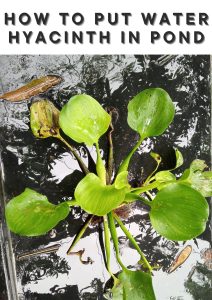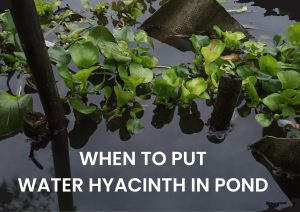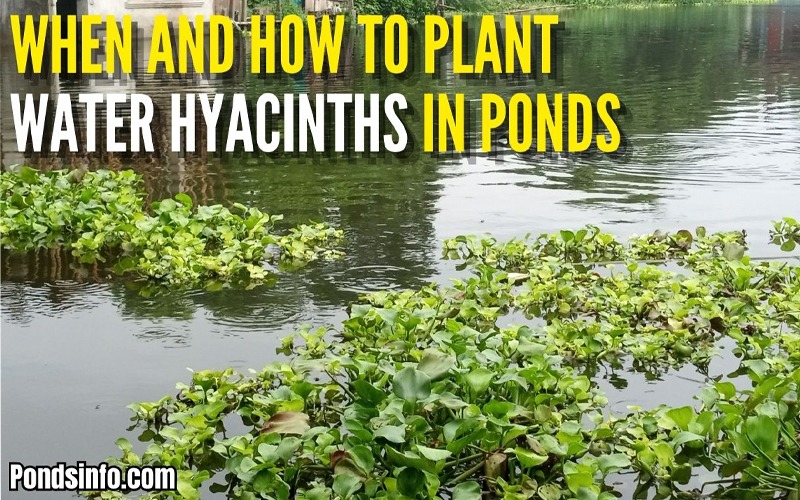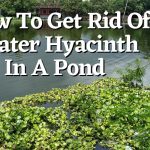Actually, there is no way to plant water hyacinths in a pond using traditional plating methods. Because water hyacinths are known as floating aquatic plants and they always float naturally on the water surface and don’t stay in a certain place.
Growing water hyacinth in Asian ponds naturally is very common, even if you don’t need to introduce your pond to these. So how they come to the ponds, there are multiple natural ways, as the fish get into new ponds naturally
Anyway, if you want to introduce your ponds with water hyacinth then you should follow some easiest steps. Today in this article we will tell you how to plant water hyacinths in ponds. And what the benefits and negative effects of having water hyacinth in a pond.
How To Put Water Hyacinth In Pond

As we mentioned before you can’t plant water hyacinth in our traditional ways. You have to introduce a water hyacinth with a pond by putting them on its water surface. And here are the steps that you should follow to put water hyacinths in a pond.
Step 1: Obtain Water Hyacinths
Before introducing, first of all, you need to collect water hyacinth for ponds. If you don’t have any water hyacinths then you can purchase water hyacinths from a nursery or pond supply store, it will cost a little bit.
Also, you don’t need to purchase much more pond water hyacinth, purchase a couple. Because water hyacinth spread fast and massively. Also, you can collect water hyacinths from an existing pond that already has water hyacinths.
Step 2: Prepare The Pond
One thing you should ensure before collecting water hyacinths for the pond is to make sure that your pond is ready to receive the water hyacinths. First, you should check the water quality, and remove any debris or excessive algae.
As well as removing excessive algae you need to make sure the pond is free from chemicals or pollution that could harm the plants. But, according to observation and our experience of planting water hyacinths on our pond, they can grow in polluted ponds also.
Step 3: Choose A Suitable Location
Now read this step carefully, because the growth of water hyacinth pond plants depends on the suitable location. Select a stable area on your pond where the water hyacinth will receive ample sunlight.
Yes, aquatic plants like water hyacinth and duckweed require full sun exposure to grow and bloom properly.
Step 4: Release The Water Hyacinths
If you locate a suitable place, now you can gently place water hyacinths in fish ponds or other ponds. They will float on the water surface naturally, but if possible then bound them in a small corner of your pond to adjust them with the water of your pond.
Step 5: Spread Them Out
To turn a normal pond into a water hyacinth pond within a few days you need to spread them. If you have lots of water hyacinths, spread them out across the pond’s surface. This will help them spread all over the pond and establish themselves more effectively.
Step 6: Monitor Their Growth
When you put water hyacinths in your pond, it’s necessary to regulate and observe them regularly. You should regularly monitor their growth and health.
Avoid overcrowding the surface area. If necessary, throw some out from the pond to balance the ecosystem.
Step 7: Provide Proper Care
Common water hyacinth pond doesn’t require too much extra care if the location and water temperature is suitable for them. Common water hyacinth ponds should be 60°F (15°C), which helps to thrive the water hyacinth.
Step 8: Control Growth If Needed
Water hyacinths indeed tend to multiply rapidly which can create bad effects on the pond’s ecosystem. If they start to cover too much, the pond surface or become too invasive.
And if they already cover the whole surface of your pond and if your pond is big then you need to use mechanical methods for larger infestations.
If you read our blogs regularly then you may notice we shared the process of removing water hyacinths from a pond, if they spread massively all over the pond.
So, these are the easiest 8 steps on how you can introduce and grow water hyacinth floating pond plants on your pond. If you can follow these steps properly you can gain some benefits from water hyacinth in your pond. And by following these steps you will see a good result within a few days.
When To Put Water Hyacinth In Pond

We have already told you how to plant water hyacinths in ponds and now here we will tell you when to put water hyacinths in ponds. Well, for Asian and African countries, there is no specific time or temperature needed to put water hyacinths in a pond.
Because the temperature from these regions always stays suitable for water hyacinth. But for Europe and North American countries, temperature matters to put and keep water hyacinths alive.
Pond plants’ water hyacinths require the warmest environment and temperature for growing. So in Europe and North America, water hyacinths can be added to a pond during the warmer months when the water temperature stays above 60°F (15°C).
Late spring or early summer consider a suitable time to introduce water hyacinths in a pond.
During this period, the warm temperatures promote the growth and establishment of water hyacinths on ponds. Additionally, water hyacinths require enough sunlight to thrive.
So you need to ensure a period when your ponds stay under the sunlight for the whole day. Keep in mind that the specific time or months that we have told here may vary depending on your location and local climate.
We just try to give you an idea about the suitable period for water hyacinths growth. But, it’s essential to consider your regional weather patterns and frost-free dates.
Additionally, it’s important to check local regulations and requirements introducing water hyacinths to your ponds. Because, in some regions, water hyacinths may be considered invasive species and there may have some instructions or restrictions for introducing water hyacinths.
As well as focusing on the planting time, you have to focus also on the growth. Also, you need to take care of them to get better results. Also, make sure water hyacinths are not overcrowded on your pond surface.
Because there are lots of negative effects of water hyacinths in ponds if they spread massively on the pond surface. So, try to monitor and control their growth.
Hope this article is helpful for you. Here we described how and when you should put water hyacinths on your ponds. If you like this article, share it with your friends who have ponds and do fish farming on their ponds. Subscribe to our blogs to get regular pond-related updates from us.





